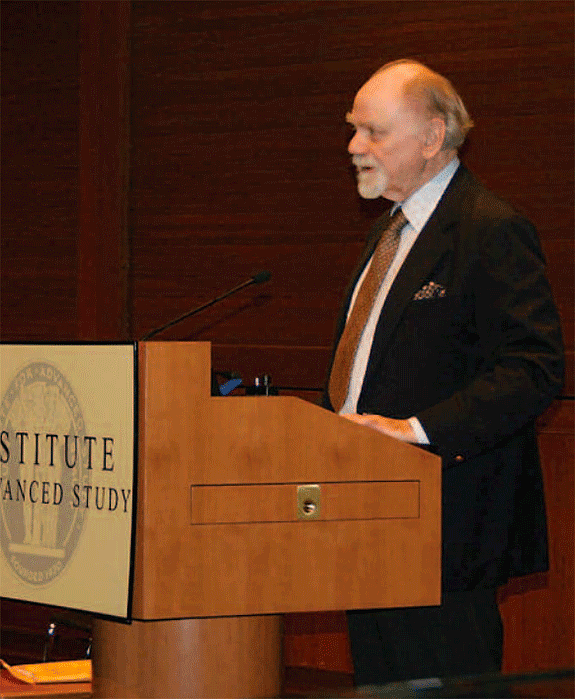Conceptions of war and of its uses, and the interaction of the arts with politics and ideology, are two different but often related areas of research in which Peter Paret, Professor Emeritus in the School of Historical Studies, specializes.
A dramatic example of this interaction was explored by Paret in “Modernism between Weimar and the Third Reich,” a talk he gave in March prior to a Sunday Afternoon Chamber Series performance by the Princeton Symphony Orchestra in Wolfensohn Hall. The program featured music by the Jewish romantic composer Felix Mendelssohn and two modernists, Erwin Schulhoff, and Anton von Webern, whose works were discredited or banned by the Third Reich in its effort to purify music from alien or degenerate elements.
Between the 1920s and 1945, a culture war was waged by National Socialism against certain forms of modernism in the arts. Paret suggested that while Mendelssohn’s, Schulhoff’s, and vonWebern’s compositions were different, they were attacked for the same underlying reason: Hitler’s belief in the ideological significance of the arts. He saw them as an arena in which good and evil forces fought over the nation’s present and future.
Hitler, Paret continued, had the insight to recognize that “in a democratic political system, which was socially and economically battered by the FirstWorldWar, one way of mobilizing people to support reactionary politics was to alert them to works they would regard as senseless or revolting, but that nevertheless were praised in newspapers, exhibited or performed, and given prizes by the state.”
Hitler accepted works of modern art in a variety of forms and styles, as long as they had what he considered healthy subjects, and as long as they treated their subjects descriptively or with humor, or idealized them. In fact, Paret observed, under Hitler’s urging the Third Reich sought out modern design and integrated it in mass culture, from the Autobahn and the Volkswagen to the design of furniture, lamps, dishes, and cutlery. But Hitler rejected distortion in the arts and their exploration of psychological conflict or social misery—frequent stylistic and thematic characteristics of modernism.
After Hitler gained power, the new government’s cultural policy remained uncertain for a time. “Hitler’s intentions being not yet clear, party leaders filled the vacuum with their own policies,” noted Paret. “Concerts and exhibitions prohibited in some parts of Germany were permitted in others, and it was possible to think that as the party became accustomed to govern, it would modify its extremes of rhetoric and policy.”
But Hitler’s very broad definition of unwanted art, and the use of undesirable music as a symbol for alien forces that threatened the German people’s sense of self, were gradually institutionalized and became central to his cultural policies, which Hitler further linked to the elimination of Jews from Germany.
Paret gave the example of the Reichsmusikkammer, which controlled music by granting or withdrawing the right to work. At first Jews, especially if they had served in the World War, were accepted, but by March 1936, more than 2,000 Jews and those associated with them through marriage or ancestry had been weeded out. For a time, composers or performers of twelve-tone or atonal music could still belong if they had influential sponsors. That was the case with von Webern, who remained a member even after he was officially denounced as a major practitioner of twelve-tone music, but who was not allowed to perform or teach.
Good art has often been made under repressive regimes, either in subversive opposition to its measures, or in agreement with them, or by ignoring them as much as possible, observed Paret. But after the first few years of the Third Reich, Hitler’s vision of totality subsumed every element of society and culture, from politics to war, from art to ethnicity, under the same ideological demand.
“It is one thing to manipulate ideas freely in an environment that affords scope to diversity, and another to do so under the constant threat of physical repression, and, indeed, of extinction,” concluded Paret. “For creativity to move in new directions in the closed society of the Third Reich, to break away from officially approved norms, and survive in the face of organized terror, was so difficult as to approach the impossible. Whether the circumstances of that time and place can be generalized to apply to comparable conditions in the future is a question that may be worth asking even if it cannot be answered.”
